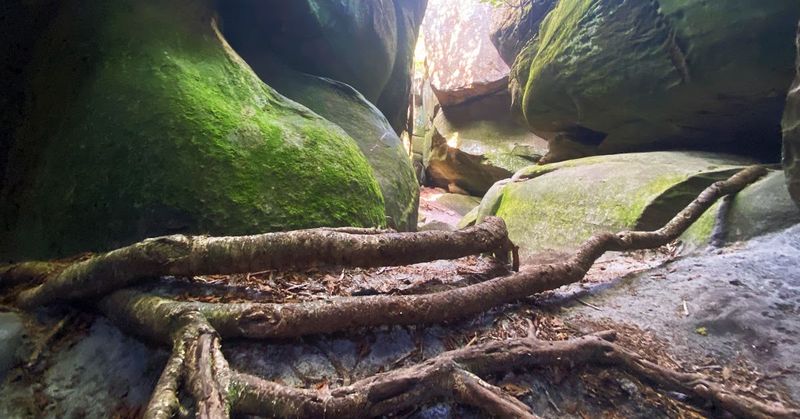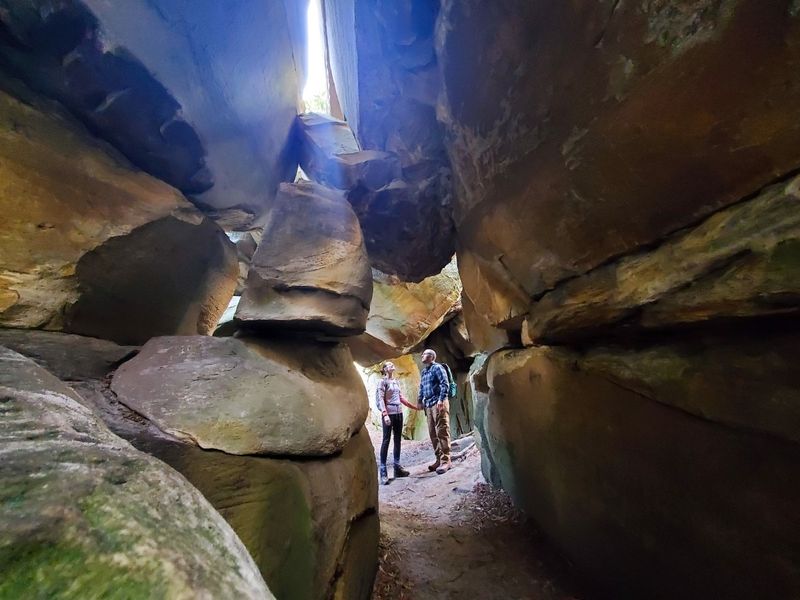In a state famous for Blue Ridge overlooks and postcard-perfect woods, one forest trail feels almost too cinematic to share. It’s not the Appalachian Trail, Old Rag, or Dark Hollow Falls. It’s the Great Channels of Virginia, carved into Clinch Mountain and hidden in plain sight. Step into this sandstone labyrinth and you’ll see why locals guard it closely – and why those who find it never forget.
1. It Feels Like Walking Into a Hollywood Set
The Great Channels seem ripped from a film storyboard – an Appalachian mash-up of Indiana Jones and Middle-earth. Turn a corner and the forest dissolves into slots and corridors, tight as alleyways and stacked with ledges. Stone walls soar overhead, their faces carved with ancient fractures that look like set-piece artistry. Every bend invites a slow pan: moss-softened shelves, fern tufts, and glowing seams of iron-rich sandstone. Sound changes, too – footsteps dampen, echoes sharpen, and the breeze threads the cracks above. It’s a real place that feels scripted, carefully lit, and improbably placed in Virginia’s backcountry.
2. A Geological Marvel 400 Million Years in the Making
These corridors trace back to deep time. The sandstone cap atop Clinch Mountain fractured along joints, then freeze-thaw cycles pried those seams open, season after season, century after century. Over millennia, the cracks widened into walkable passageways – some more than twenty feet high – stacked like a maze. Iron oxides stain the rock in coppery reds and umbers, while lichens paint pale constellations across the walls. The result is a natural puzzle box: tight slots, abrupt turns, and sudden open rooms. Standing inside, you’re surrounded by geology doing slow motion – an Ice Age chisel still visible in every line.
3. Remote by Design, And That Keeps It Quiet
Reaching the trailhead feels like slipping off the map: winding past hayfields, weathered barns, and ridgelines that stack into blue haze. There are no marquee billboards, paved plazas, or trinket stands – just a few understated signs and the soft hush of mountain wind. That remoteness is protection. It filters out the hurried and funnels in hikers who value quiet. The reward is an experience unmarred by bustle: birdsong carries; leaves tick against boots; clouds scud low across Clinch Mountain. The Great Channels remain a refuge precisely because they’re inconvenient, and nobody’s trying to make them easier.
4. A Not-Short Hike That Guards the Magic
The approach is a moderate out-and-back, roughly 6 to 7 miles round trip depending on route specifics and trailhead access. It’s not punishing, but it requires time, steady pacing, and a willingness to commit. That length thins crowds, preserving the hush that makes the labyrinth so satisfying. You’ll walk through hardwood stands, cross knobby ridges, and climb just enough to feel you’ve earned the reveal. The payoff isn’t a distant vista; it’s an immersive descent into stone. By the time you arrive, your senses have tuned to forest tempo – ready for the Channels’ sudden change of scale.
5. At the Summit, You Step Into Another World
There’s no grand overlook announcing the Channels. Instead, you crest a wooded summit and find an unassuming gap – a ladder or rock steps leading down. One step and the temperature drops; another and the light narrows to ribbons. The forest soundtrack fades, replaced by a damp hush. Stone presses close, every surface textured with time. It’s a portal moment: above, Appalachian hardwoods and breeze; below, a different climate, color, and cadence. The first turn seals the illusion. You’re not looking at the Channels – you’re inside them, following corridors like veins through Clinch Mountain’s sandstone heart.
6. Light That Belongs on a Movie Reel
Midday here can look like golden hour. Thin seams overhead act as spotlights, casting precise shafts that drift as the sun moves. Moss gleams; iron streaks burn orange; shadowed corners hold indigo cool. Photographers bring tripods for the dynamic range alone – inky recesses and blown highlights pressed inches apart. On calm days, the air feels suspended, and tiny motes sparkle like stage dust. The trick is patience: wait for a beam to pivot onto a wall’s curve or a fern rosette. In a few minutes, the scene changes again, as if a gaffer’s shifting gels.
7. Cooler, Quieter, Wilder Within the Slots
The Channels create their own weather. Even on steamy Virginia afternoons, air in the slots can run ten to twenty degrees cooler. Moisture lingers; moss pads thicken; ferns unfurl along damp shelves. In shoulder seasons you might see breath plume, while leaves above still glow green. The microclimate sharpens senses: fingertips find chilled rock, and footsteps soften on packed sand and leaf duff. Wildlife favors the edges – salamanders under stones, hawks riding thermals overhead – and the quiet makes encounters feel intimate. It’s a natural refuge, a pocket of deep-time calm tucked just beneath the ridgeline.
8. Respect Keeps This Place Pristine
The Great Channels sit within protected lands where amenities are sparse by intent. No concessions, no cell service, and few frills mean your preparation matters: maps saved offline, water carried in, trash carried out. The sandstone is fragile – graffiti scars and off-trail shortcuts can last decades. Locals credit the area’s near-pristine condition to strict Leave No Trace habits and a community that quietly stewards the maze. Stay on marked paths, step lightly, and resist carving names into history. The reward is a place that still feels undiscovered, even as word inevitably spreads.












